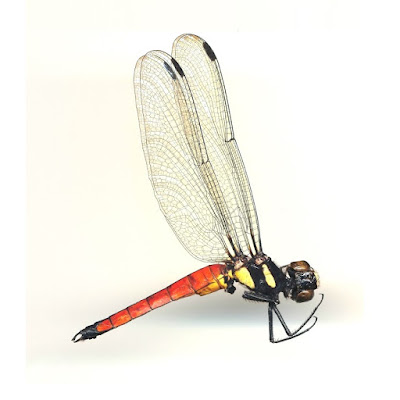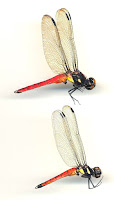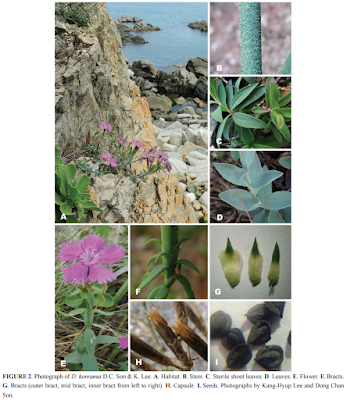[Most Recent Entries] [Calendar View]
Saturday, April 8th, 2017
| Time | Event | ||||
| 6:23a | [Entomology • 2017] Lyriothemis kameliyae spec. nov. • The Riddle of Lyriothemis bivittata (Rambur, 1842) (Odonata: Libellulidae)
Abstract Lyriothemis kameliyae spec. nov. from northern Vietnam is described and illustrated for both sexes, and descriptions are given of male and female specimens of L. bivittata collected in Vietnam. A comparison of their distinguishing characteristics is provided, and differences from similar L. tricolor are discussed. Earlier descriptions and some records of L. bivittata are evaluated. Evidently these contain at least some L. kameliyae specimens, and therefore historic records of L. bivittata require evaluation. The ranges of the two species overlap considerably. Some information is provided on the biology of L. kameliyae. Keywords: Odonata, Libellulidae, Lyriothemis kameliyae spec. nov., new species, Vietnam
Lyriothemis kameliyae spec. nov. Etymology. The species is named after Kameliya Petrova in gratitude for her assistance with my book “Dragonflies and Damselflies of the Serra dos Orgaos” and unrelenting support for my continuing research on Odonata in Vietnam. Kameliyae, a noun in the genitive case. .... Lyriothemis bivittata (Rambur, 1842) Tom Kompier. 2017. The Riddle of Lyriothemis bivittata (Rambur, 1842): Lyriothemis kameliyae spec. nov. (Odonata: Libellulidae). Zootaxa. 4250(4); 315–326. DOI: 10.11646/zootaxa.4250.4.2 | ||||
| 8:44p | [Botany • 2017] Dianthus koreanus • A New Species of Dianthus (Caryophyllaceae) from Republic of Korea
Abstract Dianthus koreanus sp. nov., from Gyeongsangbuk-do, Republic of Korea, is described and illustrated. It is a chasmophyte growing on the rocks on the seashore in the eastern coast of Korea. The new species is similar to D. chinensis by its vegetative and floral morphology. Differential characters refer to the leaves (oblanceolate to oblong and greenish-gray coriaceous), and the bracts (3 pairs, each bract being elliptic to obovate with apex acute). The conservation status of D. koreanus was assessed according to the IUCN Red List criteria. Keywords: East Asia, Dianthus chinensis, endemic species, IUCN, Eudicots Dianthus koreanus D.C. Son & K. Lee, sp. nov. Type:— KOREA. Prov. Gyeongsangbuk-do, Uljin-gun, Giseong-myeon, Mangyang-ri, Giseongmangyang beach, elevation 30 m, 16 July 2015, Lee 2453 (holotype KH-1460258!, isotype KH-1460259!). Diagnosis: Herbs perennial, 25–50 cm tall. Roots woody. Stems laxly caespitose, ascending at base, often somewhat woody towards base, densely pubescent. Leaves sessile, coriaceous; cauline leaves opposite, oblanceolate to oblong (2.5–4.5 × 0.5–1.5 cm), mid-vein prominent, apex acute to obtuse, base cuneate to attenuate, base amplexicaule, margins short ciliate, both surfaces densely pubescent, greenish-gray coloured; sterile shoot leaves similar to cauline ones, developing at flowering season. Flowers solitary or in dense cymes; pedicel 0.5–1.4 cm long; bracts 3 pairs, elliptic to obovate, about 1/4–1/2 as long as calyx, margin membranous-ciliate, apex acute. Calyx gamosepalous, cylindrical, 1.5–2.5 cm long, 5-toothed, with many parallel veins. Petals limb bright red, purple-red or pink-coloured, obovate-triangular (1.3–1.5 cm long), apex irregularly toothed; throat spotted and laxly bearded. Stamens 10, exserted, versatile; filaments long, slender; anthers blue-colored. Ovary 1-locular, on a short gynophore, with chartaceous cap; ovules many on free central placenta; styles 2, linear, longer than ovary, pubescent. Capsule cylindrical, 2.0–2.5 cm long, surrounded by calyx, apex 4-toothed. Seeds black, flat, orbicular. Etymology: The specific epithet of the new species is dedicated to the country Korea. Vernacular (Korean) name: Gaet-ba-wi-pae-raeng-i-kkot (갯바위패랭이꽃; new Korean name). Distribution: Endemic to the Province Gyeongsangbuk-do (Republic of Korea). Phenology: Flowering time late July–early August; fruiting time late August–September. Habitat and ecology: Dianthus koreanus grows on the rocks on the sunny seashores in the eastern coast of Korea (Figs. 2, 3). Its habitat is dominated by Pinus thunbergii Parlatore (1868: 388), with Arabis erecta Kim & Jang (2016: 280), Cnidium japonicum Miquel (1867: 60), Lathyrus japonicus Willdenow (1802: 1092) and Aster spathulifolius Maximowicz (1871: 216). Dong Chan Son, Hyun-Jun Kim, Kae Sun Chang, Dong-Hyuk Lee and Kang Hyup Lee. 2017. A New Species of Dianthus (Caryophyllaceae) from Republic of Korea. Phytotaxa. 303(1); 71–76. DOI: 10.11646/phytotaxa.303.1.6 |
| << Previous Day |
2017/04/08 [Calendar] |
Next Day >> |






